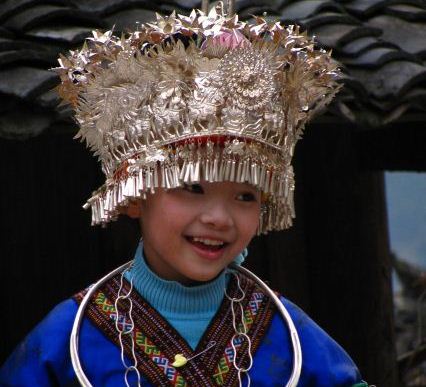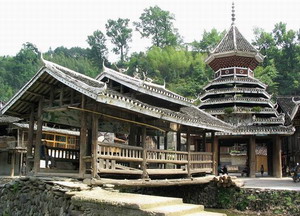Suoga Ecological Museum

Suoga is is a small town 60 km from Liuzhi, in the area of Liupanshui, the westnorthern part of Guizhou. It is the only habitat of the Longhorn Miao, a branch of the Miao ethnic group that, with a population of just 6,000, There are 12 villages, and Longga Village is the best known.
Longhorn Miaos have survived the cold weather and barren soil in the 1,600-meter Daqing Mountains for centuries, and still live a self-supporting tribal lifestyle far removed from the modern world. Foreign researchers have dubbed them living fossils of primitive society.
The Longhorn Miaos are so called due to their unique hairstyles and headdresses. Women wear wooden cones, around which they bind their hair, securing it up with white woolen cord. This headgear symbolizes the group's respect for nature.
Today, men no longer wear these long horns, other than during important festivals, and cover their heads with black handkerchiefs instead. Women still don their long horns, but seldom wrap their hair around them.
The Longhorn Miaos have a number of traditional customs that persist to this day. One is known as wedding beating', where the bride's family will playfully wrestle with the groom, the matchmaker, and his friends. Another is the Daga funeral rite, when the deceased's family receives a list of gifts from mourners carved onto bamboo which is read out before the grieving family. There are also many shamanistic sacrificial rituals.
How to get there:
All trains from Guiyang to Yunnan stop at Liuzhi. The fare for both the train and the coach is about 30 yuan. You can also take a shuttle bus from Suoga Township in front of the train station for about 10 yuan, change to a pedicab to the Miao villages for 3 to 5 yuan.
Time of Tiaohuapo Festival in 2011
On Feb 12, big ceremonies will be hosted by local government, people dress up to take part in all kinds of activities, and it is also one of the few chances for professional photographers. Activities inclusive of: Lusheng dance, Miao song singing, Buffalo fighting, etc.
Must-see Villages in Guizhou and Guangxi
Basha Zhaoxing Tang'An Xijiang Sanjiang Longsheng
Festival Calendar in Guizhou
February 2011
| Sun | Mon | Tue | Wed | Thu | Fri | Sat | ||||||||||||
1 |
2 |
3New Year |
4Congjiang |
5Sanjiang |
||||||||||||||
6Zhaoxing |
7TangAn |
8Fulu |
9 |
10 |
11 |
12Liuzhi |
||||||||||||
13 |
14 |
15 |
16 |
17 |
18 |
19 |
||||||||||||
20 |
21Kaili |
22 |
23 |
24 |
25 |
26 |
||||||||||||
27 |
28 |
|||||||||||||||||
More places to go in Guizhou

In Guizhou, Miao ethnic in Basha village might be the only native trible who still dress in traditional clothes during their work. ...more

Kaili is a city in the Qiandongnan Miao and Dong Autonomous Prefecture, a significant population of Miao and Gejia live in Kaili. Kaili is host to more than 120 Miao festivals throughout the year....more

Zhaoxing is one of the largest Dong villages in the region, many local people continue to wear traditional clothing and speak only their native Dong language. ...more
Must-see Villages in Guizhou and Guangxi
Basha Zhaoxing Tang'An Xijiang Sanjiang Longsheng
Frequently asked questions in Guizhou


